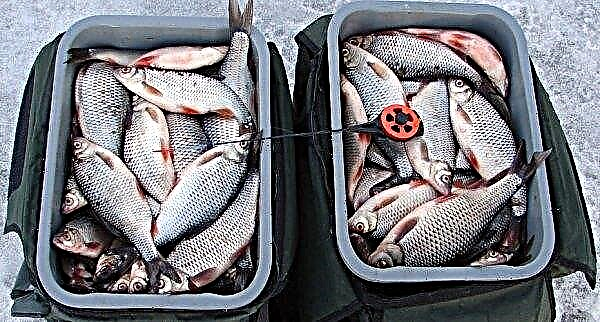Modern technology allows you to grow onions not only in the garden or greenhouse. One of the progressive methods is feather distillation in hydroponic plants. About what hydroponics is and what subtleties need to be considered with this method of plant cultivation, read below in the article.
What is hydroponics and what is it for?
Hydroponics is a method of growing crops without soil. A nutrient solution is used as a substrate. Thus, many types of plants can be grown year-round, including green onions.
Did you know? According to historians, one of the Seven Wonders of the World, the Hanging Gardens of Babylon is the first example of hydroponic cultivation.
For industrial use, hydroponic plants are used for sale - devices for mass production of greens, vegetables, fruits and berries.
Advantages and disadvantages of hydroponics
- Hydroponics has many advantages:
- economical water consumption compared to forcing in the ground;
- plant nutrition is controlled by the farmer;
- lack of need for pesticides and herbicides;
- with subsequent reproduction, a high viability of daughter plants is observed;
- potential products fully absorb nutrients;
- the grower has access to the roots and can constantly monitor the state of the rhizome;
- possibly year-round crop cultivation;
- vegetables, fruits and greens can be "obtained" even in extreme conditions;
- a small amount of space is used.
- However, the method has several disadvantages:
- the crop may die at the slightest deviation from the process;
- it is necessary to carefully monitor the microclimate in order to prevent overheating;
- many crops, such as root crops, cannot be grown hydroponically;
- hydroponic systems are expensive, so the method is financially expensive.
Suitable Onion Varieties for Hydroponics
For growing onion herbs by hydroponics, distillation varieties are suitable. Among them, the following are noted:
- Spassky;
- Union;
- Bessonovsky;
- Arzamas.

What you need for growing onions in hydroponics
Before starting the process, it is necessary to select and prepare planting material. For the forcing of the pen in hydroponics, it is better to choose the bulbs:
- from last year's crop;
- diameter - at least 2-3 cm;
- without plaque and rot.
Did you know? As of 2019, Israeli farmers grow 80% of plant products in hydroponic plants.
Before being placed in a hydroponic installation, the planting material is sparged - purged with air bubbles to saturate with oxygen. The procedure is carried out as follows:
- Soak 1 kg of bulbs in a bucket of water with a temperature of +37 ... + 39 ° С.
- Place the aquarium compressor in a bucket filled with water and turn it on.
- 2 hot-water bottles filled with hot water are attached to the outer sides of the bucket.
- Planting material is left continuously sparged for 15–20 hours.

While the above process takes place, care should be taken about the capacity for plants. At home, you can cope without professional hydroponic installations. It is enough to purchase a container with the following parameters:
- length 80 cm;
- width 40 cm;
- depth 20 cm.
 The container is often already equipped with a lid with round holes in which it is convenient to place the bulbs
The container is often already equipped with a lid with round holes in which it is convenient to place the bulbs
How is onion growing
After preparing the planting material and the container, you can proceed directly to the cultivation of onions. To successfully expel the pen, you need to take care of temperature, lighting, germination solution and proper planting care.
Temperature, light, hydroponic solutions and care
When growing onions, it is very important to observe the temperature regime. When overheating and hypothermia, the crop may die. The whole growth period is maintained at a temperature of +25 ... + 27 ° C.
 Chives grow well in plain water. For more effective growth, you can add ready-made special nutrient solutions
Chives grow well in plain water. For more effective growth, you can add ready-made special nutrient solutions
The first 10 days of planting are kept in a dark place. On day 11, the bulbs are transferred "to the light." If the container with planting material is located on the balcony, near the window, additional lighting is not required. If onions are grown in a darkened room or in winter, during a short daylight hours, additional illumination is used for additional lighting - with phytolamps, fluorescent lamps, etc.
Important! Professionals often prepare their own nutritional supplements, but a beginner may not be able to handle the process. The solution should be prepared in an optimal pH and with the correct ratio of components. Experts recommend purchasing ready-made mixtures for growing onions.
You can also plant a culture on a substrate, which is used as expanded clay or gravel. Care manipulations are simple. Immediately before planting, it is advisable to trim the tops of the bulbs so that the greens sprouted faster.
In the process of growing the rhizomes of a vegetable crop, they are daily purged with oxygen for 30–40 minutes. The procedure is conveniently carried out in automatic installations. At home, you can use aquarium compressors.

Hydroponic onion cultivation methods
Agronomists distinguish three methods of hydroponic cultivation: air, water and substrate. The methods differ significantly from each other and have their own subtleties.
Air method
The air method of growing is also called aeroponics. The rhizome of the cultivated plant with this method are in the air. To nourish and saturate with vital trace elements, the roots are regularly sprayed with water with the addition of nutrient mixtures.
Video: Growing onions in hydroponics
Water system
The water method of distillation of culture is a classic way of hydroponic cultivation. In this way, moisture-loving crops can be grown. It is difficult to grow vegetables by the water method. This method is used, mainly for herbs, including onions.
In the simplest installation design, the plants are fixed in a tray, and the root system is immersed in an aqueous nutrient solution. A sophisticated, professional method is the constant aeration of the nutrient medium. For this, vegetable growers acquire automatic installations with a compressor.

Substrate
The substrate method consists in immersing the plant in a moist substrate. Thus, greens and vegetables are constantly saturated with nutrients and water. Planting care consists in the constant regulation of the substrate and the addition of a nutrient solution.
Professional installations work using advanced technologies. The method of periodic flooding positively affects the growth of plant crops. At the same time, the rhizome is regularly immersed in a nutrient solution for some time.
 Also, drip irrigation is used for cultivation. Unlike the method of periodic immersion, the solution is supplied continuously and evenly
Also, drip irrigation is used for cultivation. Unlike the method of periodic immersion, the solution is supplied continuously and evenly
Harvest Rules
When all the recommendations are followed, the green pen reaches technical maturity in 2-3 weeks. After cutting the greens, the old bulb is removed from the hydroponic plant. With repeated distillation from the same planting material, there is a risk of decay of the mother bulb. In place of the "waste material" is placed a new one prepared according to the same rules.
Important! If putrefactive manifestations are revealed during the cultivation of a vegetable crop, a complete replacement of the bulbs is made, without waiting for the ripening of the crop.
For hydroponic onion cultivation it is not necessary to buy expensive plants. It is possible to get greens using an ordinary container and water. Subject to the above recommendations, the grower will quickly receive a quality crop.












